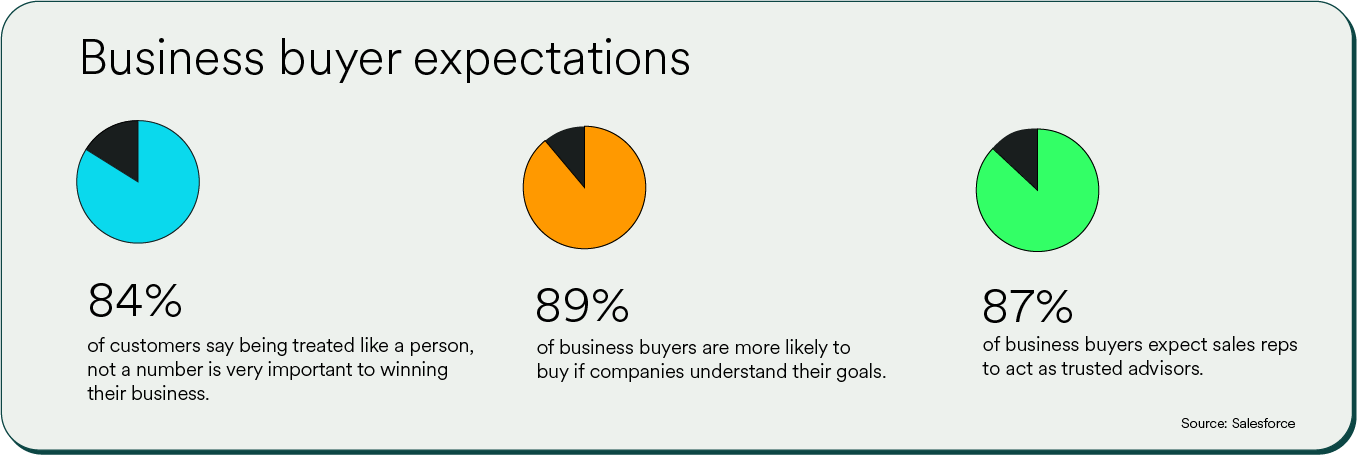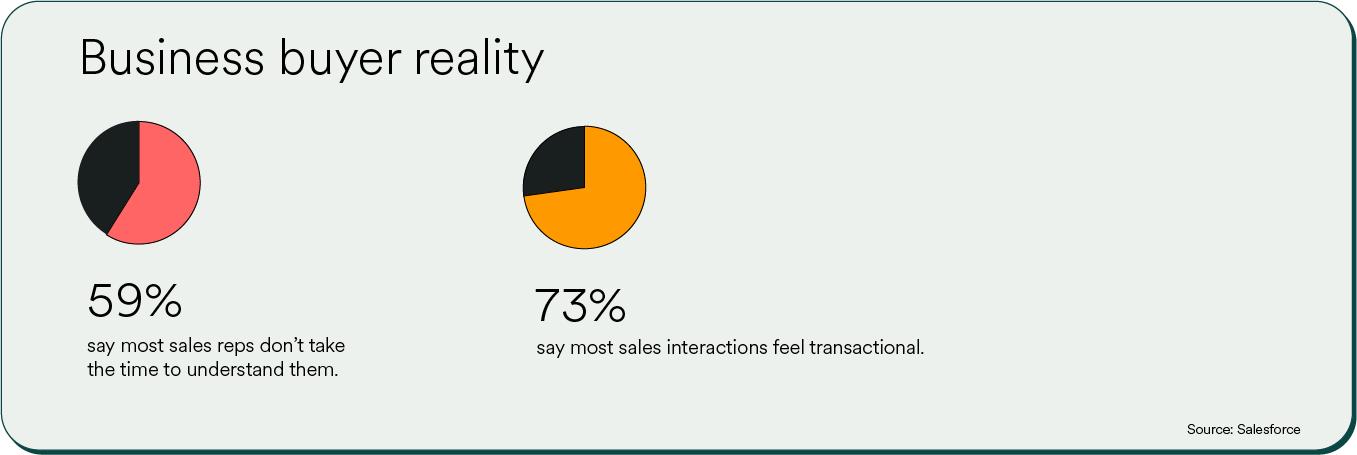
Bridging the business buyer gap
By Niels Wee // 30th of October 2024
One of my very first jobs was in telemarketing, selling ad space in themed newspapers. The daily grind was a numbers game where the mantra was A-B-C – Always Be Closing. Getting people to talk was central to our strategy, but only to create a false sense of commonality and sell ads at inflated prices – not to ensure buying from us would bring them value. Honestly, I don’t think I made a single happy customer there. It felt awful to sell like this, but I only now realize why. We did exactly what you shouldn’t do as salespeople – selling hard by creating urgency and using psychological tricks, rather than seeing the person in front of you, understanding their issue, and advising them on the best solution. There was a great divide between me as a salesperson and the clients’ needs and expectations. This is what I call the business buyer gap.
Unfortunately, there will always be a gap between the buyer’s needs and expectations on one hand, and you on the other. But it is your job to minimize the gap to pave the way for long-term client relationships. Failing to do so makes the prospect uncomfortable in the relationship because the gap prevents trust from forming between you. And whether you are aware of it or not, your organisation is suffering from it.
This article will explain the business buyer gap, why it is important, and what you should do about it.
Let’s dive in. 🤿
What is the business buyer gap?
For all the talk about being data-driven in your business, many companies seem to forget that they are dealing with real people with rich and complex lives – this is especially true on sales calls.
I know. Being your charming best self at all times can be hard, though. You likely have way too much on your plate and you may be worried about hitting your OKRs and so on. I have been there. I get it.
Nevertheless, there is still a clear expectation from the business buyer that you take the time to engage with them and understand them. They want to be treated as a person, not a number (and so do you); they want you to be an advisor on their issue and if you want their business you want to make sure that you understand their goals. The stats from Salesforce are clear about how important it is:

While few would admit they treat prospects as simple numbers, or that they don’t understand their goals and therefore can’t advise them, the experience from buyers is quite different. The majority don’t feel understood, but find sales to be impersonal.

This is exactly the issue that the business buyer gap describes: the lack of understanding of the client or prospect from the employee. It hurts not only the immediate sale but also the long-term relationship your organisation has with them and hence they might churn quicker, than if you took the time to establish the relationship of the long haul.
A lack of good and personal understanding of the buyer’s issue and unique situation, and seeing them as whole people, stands in the way of building rapport, empathy and trust with you as a representative and your organization.
Use empathy and context as leverage
I wholeheartedly agree with Sean Ellis that empathy and truly getting where your customer is coming from, are overlooked opportunities for sales. Why? Only then can you show them exactly how your product is the missing piece to get the job done.
“...sustainable growth lies in something more fundamental: empathy. Truly understanding your customers' context and needs enables you to deliver a solution that feels indispensable in their lives.”
Sean Ellis
In other words, if the person in front of you doesn’t feel seen, heard, and understood you are fighting a losing battle as a sales rep. Simply selling harder rarely works, but often results in a greater divide. If, on the contrary, you can put yourself in the shoes of the prospect (that is empathy), you can also navigate their reality, and show how your solution fits the bill. Saying yes to the deal all of a sudden becomes an easy decision.
You may be thinking that it takes too much time and effort to do right. Yes, it is correct, that closing the gap doesn’t come easy. But the sooner you get to a place of trust and understanding, the quicker you can reach an agreement or move on to a more promising conversation.
Of course, that is not the reality for many reps, who tend to forget that people buy from people. However, if your team manages to create and sustain empathy and understand the reality of the client, you have an amazing leverage at your disposal.
But one thing is the sales aspect of the business buyer gap. Do other customer-facing teams, not to mention the organization as a whole, need to know about the client? Yes, if they’re interested in keeping them as customers.
Surprising stats on sales professionals
1 in 5
of high-performing sales teams highly rank the importance of collaboration and knowledge sharing.
70%
of sales professionals say their sales + marketing teams are not strongly aligned.
82%
of sales pros say building relationships + connecting with people is the most important and enjoyable part of selling.
Source: Hubspot.com
Importance of internal customer alignment
Alright, so sales have done amazingly landing a big client after careful attention, countless meetings, and advising them based on their unique situation and pains. What then? The answer should be internal customer alignment, but all too often it is not.
Even sales reps who manage to get to a place of trust and common understanding tend to throw it away in the next instance. The reason? They fail to share all the rich knowledge and insights about the client with other colleagues who will play a key role in the experience for the client going forward. The business buyer gap is hence not limited to sales, but the entire company.
I know, I know. Sales have plenty to attend to and documenting conversation topics that are obvious to them may seem like time that could be spent better elsewhere. But for the organisation, this is vital information that will put a support agent, customer success manager, or someone covering for you, in a much better position.
It is the difference between your colleagues having to ask the client:
‘So let us start from the top. Who are you?’
…or…
‘Casper told me that your issue is [this] and that your goals are [that]. Is that correct? – Great, let’s get on with it as I have a solution that seems to fit to purpose’.
Tell me which experience you prefer as a buyer? I would go for the latter.
Even if you are not part of a customer-facing team, but work on a strategic level or run marketing and communications, understanding your customers will crucial for you to make the right decisions.
Internal customer alignment allows another level of organizational agility when things change on the client side. Exactly because you get them as an organisation, you are in a great position to maintain or deepen their feeling of being understood. It simply becomes easier for you to work in the same direction, and so does the likelihood of delivering good experiences and value for the client. Hence building a lasting client relationship based on context, empathy, and trust increases. So also in this way, does closing the business buyer gap pay off. That is good news for the bottom line.
On the other hand, if the business buyer gap is not actively addressed with good alignment practices, valuable insights are lost and relations erode. E.i. if the main contact leaves your company without a proper handover, it can become the silent killer of sales and the cause for churn. Your customer will be more willing to jump ship, and you lose out on all your work. So what can you do today to enable sales and help the lifetime value of your customers?
How to bridge the business buyer gap
1: Keep asking questions, be curious.
It is so tempting to only ask a few initial questions, and let assumptions based on your previous experience with other clients take over. But the less the prospect unfolds their situation, the more likely you are to make wrong assumptions. So keep exploring who they are and their lived experiences to deepen the understanding. Even venture out in aspects that might not be directly related, because this gives you a much more context that will help you in the long run.
Do this during sales process, but also at later stages when you get the chance. Things might be changing and you want to be in the know.
So rather than ‘Always Be Closing’ you should ‘Always Be Contextual’. The more curious you are, the better you will be at advising them in their unique situation and the more trust you build with them.
2: Make sure to take good notes
Notes are nothing new, but continually writing notes on the conversations and the relationship with a client will make a significant difference down the line for you and your entire organisation. Keeping all the insights in your head invites cognitive biases like confirmation bias, especially because you will eventually forget or mix up the important details.
Notes are what give the rest of the data around a prospect or client context. So having detailed records of interactions, perspectives, ideas, meetings and so on and so on, will become a goldmine in many cases. Failing to note important aspects down, however, only leads to lost insights.
Tip: warm and cold data
Reviewing the warm data, such as you and your colleague’s notes, and the cold data analytics together, will give you a significant advantage in building on the relationship.
3: Share your knowledge
You hate reading it, I don’t like writing it, but I will do it anyway: Sharing is caring… and siloing information never helped anybody. You’re representing a company, and so sharing things of even minor importance now, could turn into key insights to navigate by at a later stage for your colleagues.
When teams consistently share the knowledge they pick up with clients, this information adds up to a history of building trust and understanding that can only be achieved over time. The better this common foundation is, the greater the staying power of the relationship. However, if there is a lack of documented history, there is also the risk of widening the business buyer gap. You don’t want that
4: Have a clear process in place (and culture)
Continuous curiosity, note-taking, and knowledge sharing will automatically help bridge the business buyer gap and strengthen the staying power of your product. But all this is also easier said than done. Simply asking people to do something, has yet to inspire lasting behavioral change.
Exactly for this reason you need to make sure that you and your colleagues have the right process and tools available to most effectively capture the relational information. But how?
- Make it easy and efficient to do.
- Have employee do notes while it is still fresh in their mind.
- Create a culture where questions, note taking, and sharing are expected integral parts of operations, not a nice to have.
- Ensure that your team have the necessary tools to do this efficiently.
How Stinto can help
Narrowing the distance between the buyer and your organisation is one of the main problems Stinto helps resolve. We help organizations expand their network and share rich relational insights as well as contact data into the CRM system. In this way, we shorten sales cycles, enable internal customer alignment, reduce lost opportunities and increase lifetime value, for the benefit of your prospects, customers, and your organization.
We do this with our reimagined digital business card. It works like this.

